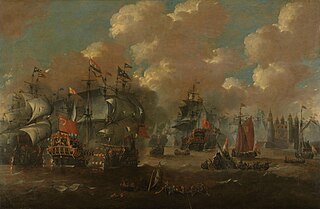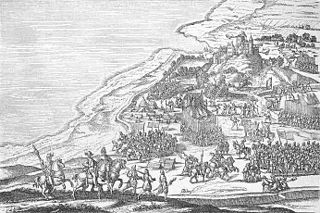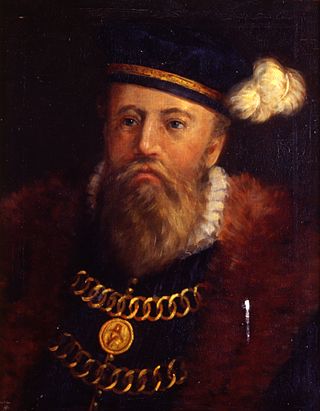
Bornholm is a Danish island in the Baltic Sea, to the east of the rest of Denmark, south of Sweden, northeast of Germany and north of Poland.

Rønne is the largest town on the Danish island of Bornholm in the Baltic Sea. It has a population of 13,759. It was a municipality in its own right from 1970 until 2002, when Bornholm was a county. It has an area of 29.11 square kilometres, and is the administrative centre of the Bornholm municipality. As of 2018 11,539 inhabitants live in Rønne Parish, which is a narrow piece of land on the westernmost of the island and stretching north and southward comprising around a third of the area of the former municipality. Knudsker Parish made up the rest of the former municipality. Not all inhabitants of either Rønne or Knudsker (400-7553) parishes live in the city of Rønne.

The Battle of Copenhagen of 1801, also known as the First Battle of Copenhagen to distinguish it from the Second Battle of Copenhagen in 1807, was a naval battle in which a British fleet fought and defeated a smaller force of the Dano-Norwegian Navy anchored near Copenhagen on 2 April 1801. The battle came about over British fears that the powerful Danish fleet would ally with France, and a breakdown in diplomatic communications on both sides.

The Battle of Öland was a naval battle between an allied Danish-Dutch fleet and the Swedish navy in the Baltic Sea, off the east coast of Öland on 1 June 1676. The battle was a part of the Scanian War (1675–79) fought for supremacy over the southern Baltic. Sweden was in urgent need of reinforcements for its north German possessions; Denmark sought to ferry an army to Scania in southern Sweden to open a front on Swedish soil.

The Battle of Møn, also known as the Battle of Fehmarn, took place 31 May–1 June 1677, as part of the Scanian War. A smaller Swedish squadron under Admiral Erik Sjöblad attempted to sail from Gothenburg to join the main Swedish fleet in the Baltic Sea. It was intercepted by a superior Danish-Norwegian force under Niels Juel and decimated over the course of two days. The Swedes lost 8 ships and over 1,500 men dead, injured or captured, including Admiral Sjöblad himself, while the Danish losses were insignificant.

The Gunboat War was a naval conflict between Denmark–Norway and Great Britain supported by Sweden during the Napoleonic Wars. The war's name is derived from the Danish tactic of employing small gunboats against the materially superior Royal Navy. In Scandinavia it is seen as the later stage of the English Wars, whose commencement is accounted as the First Battle of Copenhagen in 1801.

The Battle of Fehmarn (1644) took place north-west of the island of Fehmarn, now part of Germany, in the Baltic Sea. A combined Swedish fleet, with a large element of hired Dutch ships, defeated a Danish-Norwegian fleet and took 1,000 prisoners, including Ulfeldt, Grabov and von Jasmund. The Danish admiral Pros Mund was killed in the battle.

The Battle of the Sound was a naval engagement which took place on 8 November 1658 during the Second Northern War, near the Sound or Øresund, just north of the Danish capital, Copenhagen. Sweden had invaded Denmark and an army under Charles X of Sweden had Copenhagen itself under siege. The Dutch fleet was sent to prevent Sweden from gaining control of both sides of the Sound and thereby controlling access to the Baltic Sea as well as of its trade.

The Northern Seven Years' War was fought between the Kingdom of Sweden and a coalition of Denmark–Norway, Lübeck, and Poland–Lithuania between 1563 and 1570. The war was motivated by the dissatisfaction of King Frederick II of Denmark with the dissolution of the Kalmar Union, and the will of King Eric XIV of Sweden to break Denmark's dominating position. The fighting continued until both armies had been exhausted, and many men died. The resulting Treaty of Stettin was a stalemate, with neither party gaining any new territory.

The Battle of Køge Bay was a naval battle between Denmark-Norway and Sweden that took place in the bay off of Køge 1–2 July 1677 during the Scanian War. The battle was a major success for Admiral Niels Juel and is regarded as the greatest naval victory in Danish naval history.

The Battle of Vyborg Bay was a naval battle fought between Russia and Sweden on 3 July 1790 in Vyborg Bay off the coast of Vyborg during the Russo-Swedish War (1788–1790). The Swedish Navy suffered heavy losses, losing seven ships of the line and three frigates, but Gustav III of Sweden eventually ensured a Swedish naval escape through a Russian naval blockade composed of units of the Baltic Fleet, commanded by Admiral Vasily Chichagov. British historians would later call the Battle of Vyborg Bay the "Baltic Trafalgar". The battle ranks among the world's largest historical naval battles and also among the most influential, as it introduced the naval battle concept of "firepower over mobility".

The battle of Bornholm was a naval battle between a superior Swedish and a smaller Danish-Dutch fleet that was fought 25–26 May 1676 as a part of the Scanian War. The objective for both sides was naval supremacy in the southern Baltic Sea. The Swedish commander Lorentz Creutz sought to destroy the allied fleet and then land reinforcements in Swedish Pomerania to relieve the Swedish forces in northern Germany. The aim of the Danish fleet under Niels Juel was to prevent this reinforcement without being destroyed by the superior numbers of the Swedish forces.

The Dano-Swedish War of 1658–1660 was a war between Denmark–Norway and Sweden, with the former backed by the Dutch Republic and Poland. It is known in Denmark as the Second Karl Gustav War, in Norway as Bjelkes Feud in Sweden as Karl Gustav's Second Danish War, and in the Netherlands as the Swedish-Dutch War.

The Battle of Bornholm was a naval engagement that took place in June 1535. The conflict saw Lübeck and the Hanseatic League engaged against the forces of Sweden, Prussia, Holstein, and Denmark. The Battle of Bornholm was part of the larger Count's Feud.

The invasion of Rügen of 22 to 24 September 1678 was a military operation in the Swedish-Brandenburg War, or Scanian War, that ended with the annexation of the Swedish-ruled island of Rügen by the Allies – Brandenburg-Prussia and Denmark – for just under a year before it was restored by treaty to Sweden.

Jakob Tordsson Bagge was a Norwegian born, Swedish admiral and nobleman.

Otte Ruud, born 1520, died 1565, was a Danish-Norwegian admiral during the Northern Seven Years' War, who died in Swedish captivity. He spent his youth in foreign military service, and then held different fiefs from the King. Called up to duty during the war, he at first distinguished himself at land, later becoming a ship's captain, and finally admiral commanding the Danish fleet.

Michael Bille (1680–1756) was an officer in the Danish Royal Navy during the Great Northern War. He was commissioned as a junior lieutenant in 1699, advancing steadily to become Vice Admiral when he retired in 1737.

The Polish–Swedish War (1563–1568), also called the First Polish War was waged primarily in the Baltic during the larger Northern Seven Years' War between Sweden and the Polish–Lithuanian union, the Duchy of Courland, parts of the Livonian nobility, and Estonian rebels from 1563 to 1568. The war ultimately ended when John III became the King of Sweden, resulting in a Swedish victory.

The skirmish at the Isle of Wight was a brief naval skirmish between Swedish and English warships off the Isle of Wight on 1 May 1647 during the English Civil War. It ended with the Swedish outrunning their English pursuers, although one Swedish warship was later taken by the English into the Downs on 3 May after being discovered at anchor in Boulogne-sur-Mer.





















